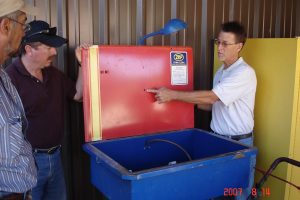 Does your safety leader need to be the top safety expert in your organization?
Does your safety leader need to be the top safety expert in your organization?
EHS Daily Advisor took a look at what the leaders of the world’s safest companies had in common. They learned that organizations in the top quartile of safety participation have an incident rate of 3.5 times lower than the bottom quartile.
After conducting interviews to learn how the safety leaders from the safest companies developed their cultures, EHS Daily Advisor found they took five important steps:
- The CEO commits to maintaining a safe workplace and does so publicly.
- The CEO appoints a safety leader and provides him or her with the tools to drive change.
- The safety leader is supported by frontline employees.
- Managers respond quickly to new safety initiatives.
- The organization expands the safety program to other departments or sites.
Your first thought may be to hire someone with a strong safety background. However, that might not be the best move.
What Skills Should Your Safety Leader Possess?
- The ability to drive change: This is the most essential skill that your safety leader can have. You may already have a leader like this in your company. It could be an A-player who you hired to turn around a department that was struggling. It’s easy to hire someone who is skilled in change management and train him or her in safety. It’s much more difficult to go the other way around. Your safety leader doesn’t serve the role of “safety cop” who tells employees to wear their protective equipment. This person is a change agent who develops a culture of safety where all workers put on their protective equipment without even thinking about it.
- Experience leading large projects: Cultivating a safety culture will require new tools, so your safety leader should be experienced in taking the lead for a large procurement operation where he or she has to select the right vendor or solution, present the business case to upper management and stakeholders, and secure the necessary funding.
- The capability to work well with your frontline staff: Your frontline employees are the people who carry out the daily work, so the safety leader must earn their support. Your safety leader must convey to employees that a safe workplace ensures everyone goes home safely every day, and that a better safety record allows the company to gain more contracts, increasing job security for employees.
- The aptitude to connect well with managers: Safety leaders must make sure that managers have the resources and systems they need to respond to new safety initiatives. If managers’ workloads prevent them from responding to safety activities in a timely manner, frontline employees will become frustrated and the safety leader will likely lose their support.
A strong safety culture isn’t achieved. Instead, it’s maintained. The safety leader you promote or hire must be able to lead the changes that push your organization in the right direction, ensure that these changes are maintained, and sustain a culture of safety for the long term.
Adapted from: Finding the Right Leader to Drive Safety Participation, EHS Daily Advisor, Josh LeBrun.